YAMAHA YZ85 2013 Manual PDF
Manufacturer: YAMAHA, Model Year: 2013, Model line: YZ85, Model: YAMAHA YZ85 2013Pages: 88, PDF Size: 1.74 MB
Page 71 of 88
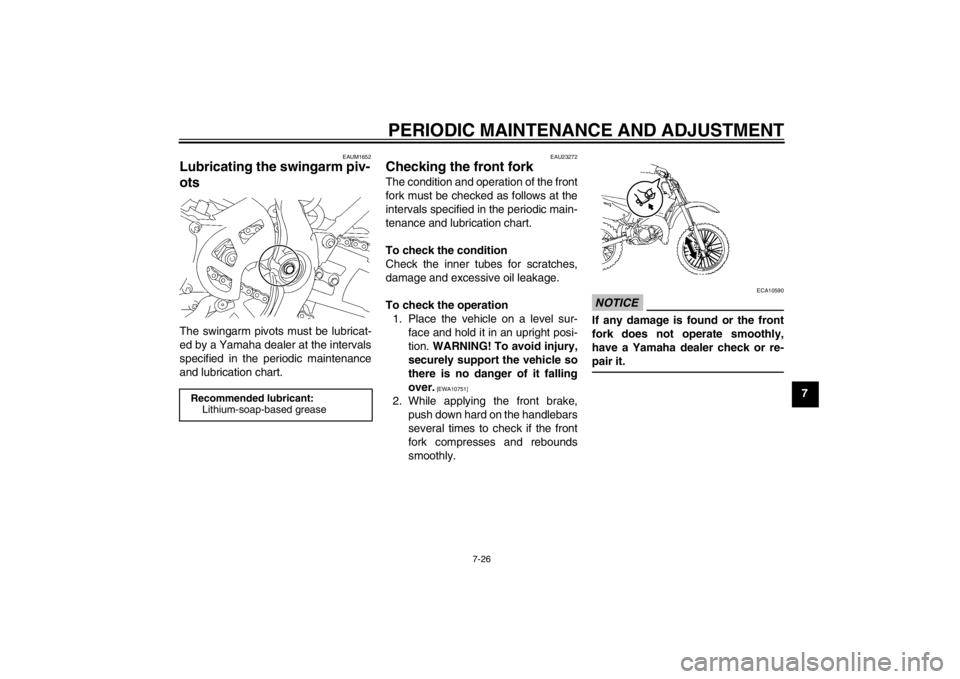
PERIODIC MAINTENANCE AND ADJUSTMENT
7-26
7
EAUM1652
Lubricating the swingarm piv-
ots The swingarm pivots must be lubricat-
ed by a Yamaha dealer at the intervals
specified in the periodic maintenance
and lubrication chart.
EAU23272
Checking the front fork The condition and operation of the front
fork must be checked as follows at the
intervals specified in the periodic main-
tenance and lubrication chart.
To check the condition
Check the inner tubes for scratches,
damage and excessive oil leakage.
To check the operation1. Place the vehicle on a level sur- face and hold it in an upright posi-
tion. WARNING! To avoid injury,
securely support the vehicle so
there is no danger of it falling
over.
[EWA10751]
2. While applying the front brake, push down hard on the handlebars
several times to check if the front
fork compresses and rebounds
smoothly.
NOTICE
ECA10590
If any damage is found or the front
fork does not operate smoothly,
have a Yamaha dealer check or re-
pair it.
Recommended lubricant:Lithium-soap-based grease
U1SN81E0.book Page 26 Tuesday, June 12, 2012 3:17 PM
Page 72 of 88
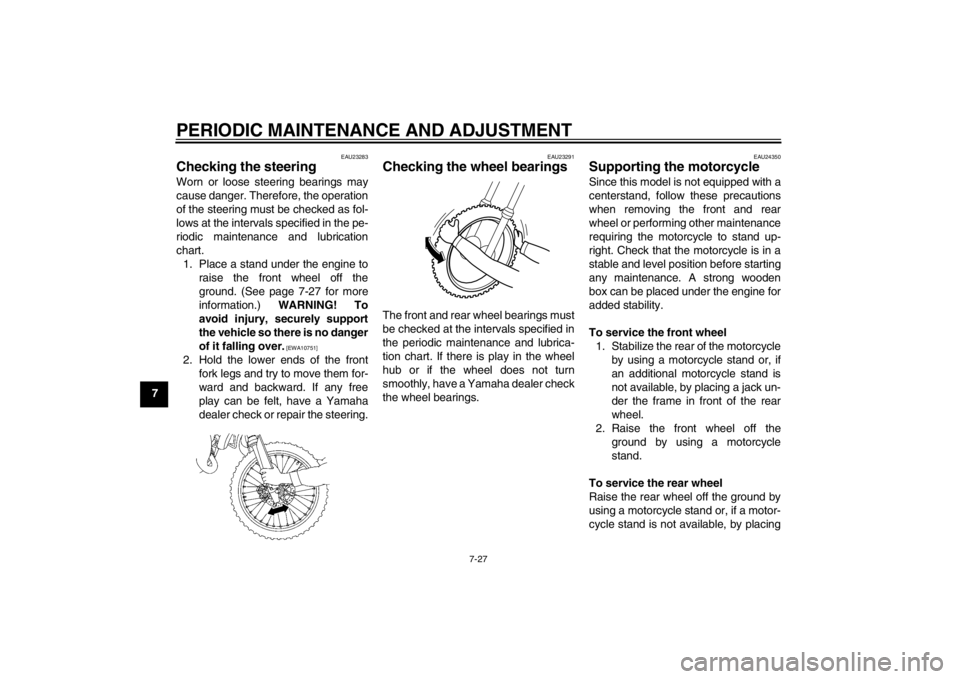
PERIODIC MAINTENANCE AND ADJUSTMENT
7-27
7
EAU23283
Checking the steering Worn or loose steering bearings may
cause danger. Therefore, the operation
of the steering must be checked as fol-
lows at the intervals specified in the pe-
riodic maintenance and lubrication
chart.1. Place a stand under the engine to raise the front wheel off the
ground. (See page 7-27 for more
information.) WARNING! To
avoid injury, securely support
the vehicle so there is no danger
of it falling over.
[EWA10751]
2. Hold the lower ends of the front fork legs and try to move them for-
ward and backward. If any free
play can be felt, have a Yamaha
dealer check or repair the steering.
EAU23291
Checking the wheel bearings The front and rear wheel bearings must
be checked at the intervals specified in
the periodic maintenance and lubrica-
tion chart. If there is play in the wheel
hub or if the wheel does not turn
smoothly, have a Yamaha dealer check
the wheel bearings.
EAU24350
Supporting the motorcycle Since this model is not equipped with a
centerstand, follow these precautions
when removing the front and rear
wheel or performing other maintenance
requiring the motorcycle to stand up-
right. Check that the motorcycle is in a
stable and level position before starting
any maintenance. A strong wooden
box can be placed under the engine for
added stability.
To service the front wheel1. Stabilize the rear of the motorcycle by using a motorcycle stand or, if
an additional motorcycle stand is
not available, by placing a jack un-
der the frame in front of the rear
wheel.
2. Raise the front wheel off the ground by using a motorcycle
stand.
To service the rear wheel
Raise the rear wheel off the ground by
using a motorcycle stand or, if a motor-
cycle stand is not available, by placing
U1SN81E0.book Page 27 Tuesday, June 12, 2012 3:17 PM
Page 73 of 88
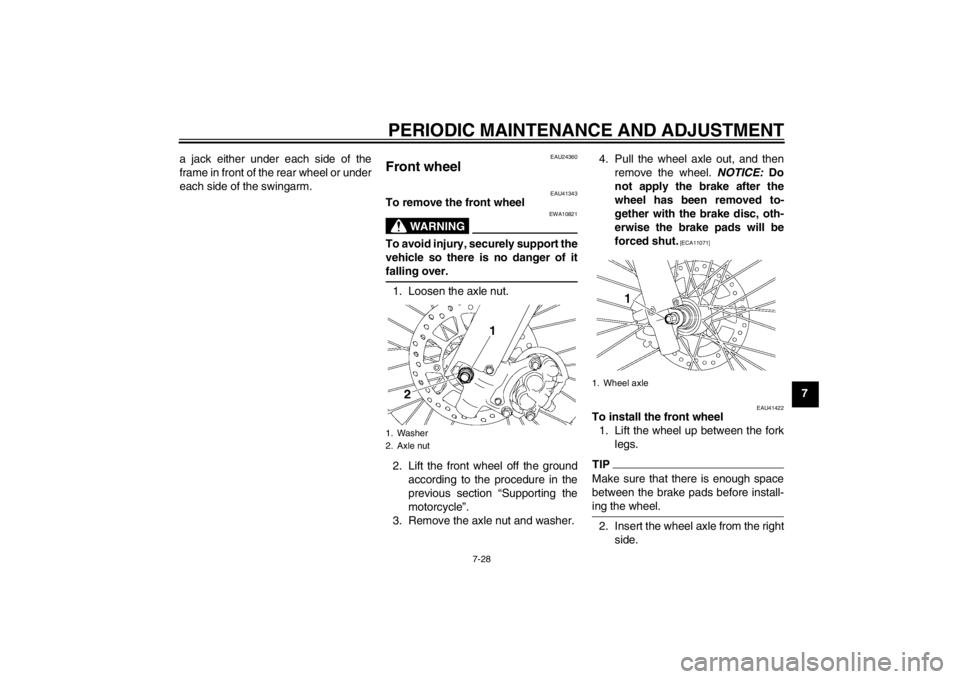
PERIODIC MAINTENANCE AND ADJUSTMENT
7-28
7
a jack either under each side of the
frame in front of the rear wheel or under
each side of the swingarm.
EAU24360
Front wheel
EAU41343
To remove the front wheel
WARNING
EWA10821
To avoid injury, securely support the
vehicle so there is no danger of it
falling over.1. Loosen the axle nut.
2. Lift the front wheel off the ground
according to the procedure in the
previous section “Supporting the
motorcycle”.
3. Remove the axle nut and washer. 4. Pull the wheel axle out, and then
remove the wheel. NOTICE: Do
not apply the brake after the
wheel has been removed to-
gether with the brake disc, oth-
erwise the brake pads will be
forced shut.
[ECA11071]
EAU41422
To install the front wheel1. Lift the wheel up between the fork legs.TIPMake sure that there is enough space
between the brake pads before install-
ing the wheel.2. Insert the wheel axle from the rightside.
1. Washer
2. Axle nut
1. Wheel axle
U1SN81E0.book Page 28 Tuesday, June 12, 2012 3:17 PM
Page 74 of 88
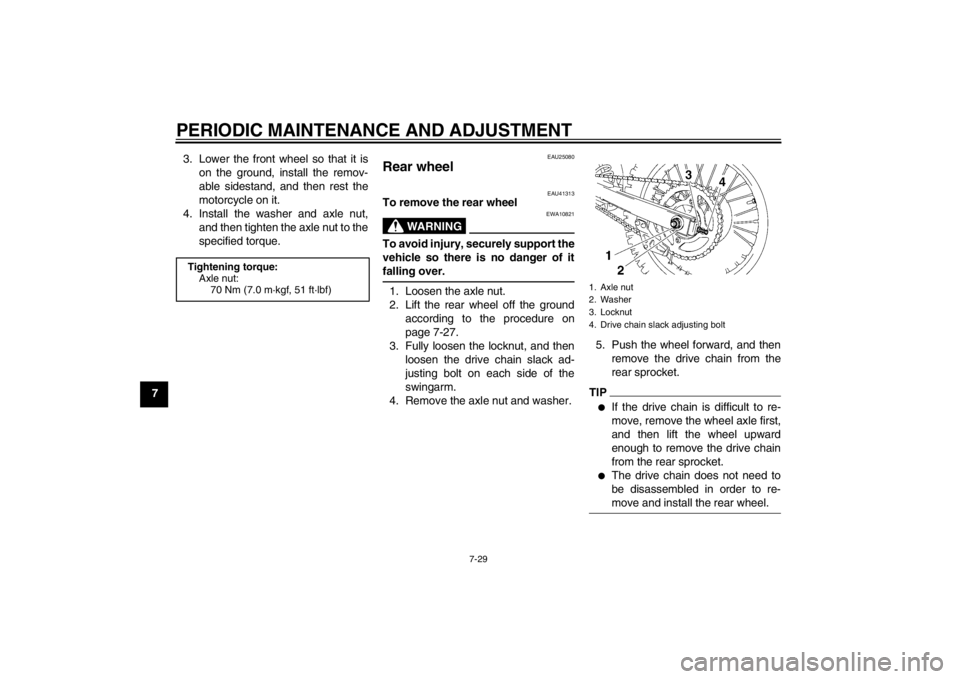
PERIODIC MAINTENANCE AND ADJUSTMENT
7-29
73. Lower the front wheel so that it is
on the ground, install the remov-
able sidestand, and then rest the
motorcycle on it.
4. Install the washer and axle nut, and then tighten the axle nut to the
specified torque.
EAU25080
Rear wheel
EAU41313
To remove the rear wheel
WARNING
EWA10821
To avoid injury, securely support the
vehicle so there is no danger of it
falling over.1. Loosen the axle nut.
2. Lift the rear wheel off the groundaccording to the procedure on
page 7-27.
3. Fully loosen the locknut, and then loosen the drive chain slack ad-
justing bolt on each side of the
swingarm.
4. Remove the axle nut and washer. 5. Push the wheel forward, and then
remove the drive chain from the
rear sprocket.
TIP●
If the drive chain is difficult to re-
move, remove the wheel axle first,
and then lift the wheel upward
enough to remove the drive chain
from the rear sprocket.
●
The drive chain does not need to
be disassembled in order to re-
move and install the rear wheel.
Tightening torque:Axle nut:70 Nm (7.0 m·kgf, 51 ft·lbf)
1. Axle nut
2. Washer
3. Locknut
4. Drive chain slack adjusting bolt
U1SN81E0.book Page 29 Tuesday, June 12, 2012 3:17 PM
Page 75 of 88
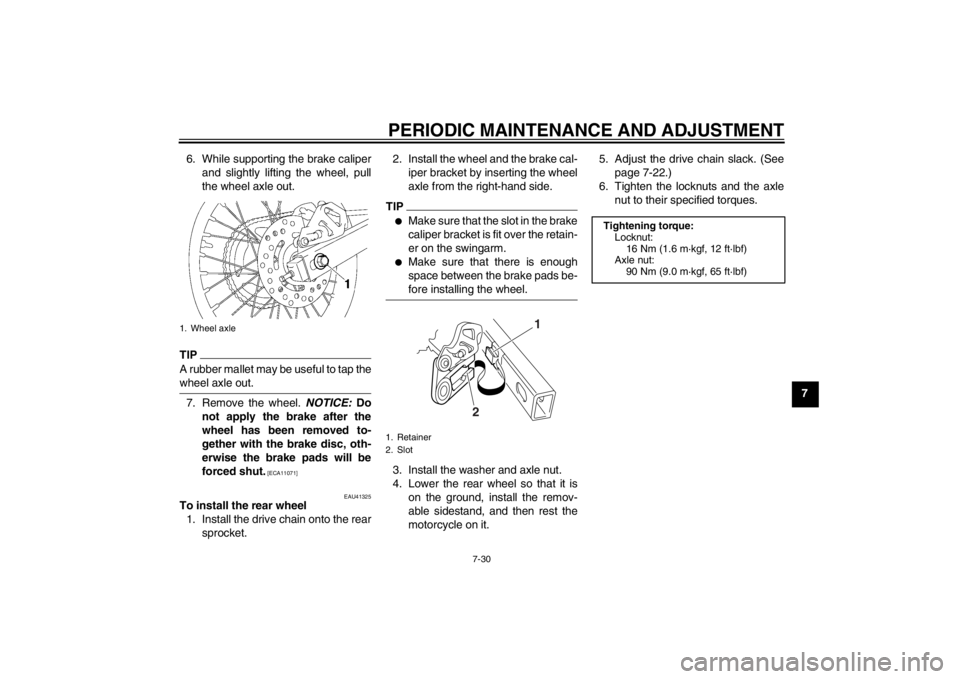
PERIODIC MAINTENANCE AND ADJUSTMENT
7-30
7
6. While supporting the brake caliper
and slightly lifting the wheel, pull
the wheel axle out.
TIPA rubber mallet may be useful to tap the
wheel axle out.7. Remove the wheel. NOTICE: Do
not apply the brake after the
wheel has been removed to-
gether with the brake disc, oth-
erwise the brake pads will be
forced shut.
[ECA11071]
EAU41325
To install the rear wheel1. Install the drive chain onto the rear sprocket. 2. Install the wheel and the brake cal-
iper bracket by inserting the wheel
axle from the right-hand side.
TIP●
Make sure that the slot in the brake
caliper bracket is fit over the retain-
er on the swingarm.
●
Make sure that there is enough
space between the brake pads be-
fore installing the wheel.
3. Install the washer and axle nut.
4. Lower the rear wheel so that it ison the ground, install the remov-
able sidestand, and then rest the
motorcycle on it. 5. Adjust the drive chain slack. (See
page 7-22.)
6. Tighten the locknuts and the axle nut to their specified torques.
1. Wheel axle
1. Retainer
2. Slot
2 1
Tightening torque:
Locknut: 16 Nm (1.6 m·kgf, 12 ft·lbf)
Axle nut:
90 Nm (9.0 m·kgf, 65 ft·lbf)
U1SN81E0.book Page 30 Tuesday, June 12, 2012 3:17 PM
Page 76 of 88

PERIODIC MAINTENANCE AND ADJUSTMENT
7-31
7
EAU25871
Troubleshooting Although Yamaha motorcycles receive
a thorough inspection before shipment
from the factory, trouble may occur dur-
ing operation. Any problem in the fuel,
compression, or ignition systems, for
example, can cause poor starting and
loss of power.
The following troubleshooting charts
represent quick and easy procedures
for checking these vital systems your-
self. However, should your motorcycle
require any repair, take it to a Yamaha
dealer, whose skilled technicians have
the necessary tools, experience, and
know-how to service the motorcycle
properly.
Use only genuine Yamaha replace-
ment parts. Imitation parts may look like
Yamaha parts, but they are often inferi- or, have a shorter service life and can
lead to expensive repair bills.
WARNING
EWA15141
When checking the fuel system, do
not smoke, and make sure there are
no open flames or sparks in the ar-
ea, including pilot lights from water heaters or furnaces. Gasoline or
gasoline vapors can ignite or ex-
plode, causing severe injury or
property damage.U1SN81E0.book Page 31 Tuesday, June 12, 2012 3:17 PM
Page 77 of 88

PERIODIC MAINTENANCE AND ADJUSTMENT
7-32
7
EAU41493
Troubleshooting charts Starting problems or poor engine performance
Check the fuel level in
the fuel tank.1. Fuel
There is
enough fuel.
There is
no fuel.
Supply fuel.
Operate the kickstarter.2. Compression
There is compression.
There is
no compression. Check the ignition.
Have a Yamaha dealer
check the vehicle.
Remove the spark plug
and check the electrodes.3. Ignition
Wet
Dry Wipe off with a dry cloth and correct the
spark plug gap, or replace the spark plug.
Have a Yamaha dealer check the vehicle.
The engine does not start.
Have a Yamaha dealer check the vehicle.
Open the throttle halfway and operate
the kickstarter.
Check the compression.
The engine does not start.
Check the compression.
U1SN81E0.book Page 32 Tuesday, June 12, 2012 3:17 PM
Page 78 of 88
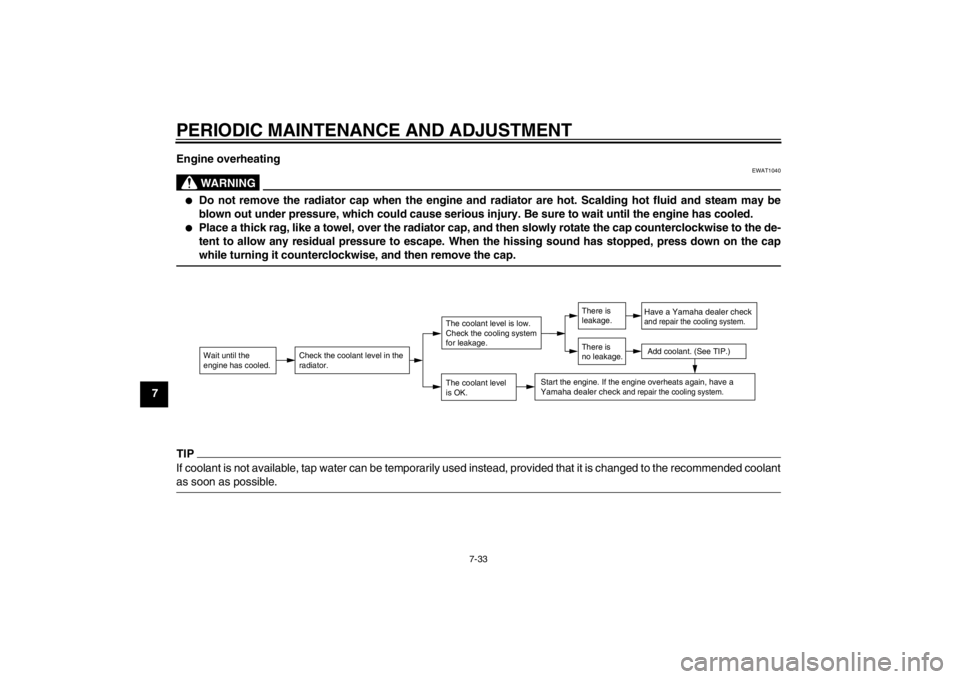
PERIODIC MAINTENANCE AND ADJUSTMENT
7-33
7Engine overheating
WARNING
EWAT1040
●
Do not remove the radiator cap when the engine and
radiator are hot. Scalding hot fluid and steam may be
blown out under pressure, which could cause serious injury. Be sure to wait until the engine has cooled.
●
Place a thick rag, like a towel, over the radiator cap, and then slowly rotate the cap counterclockwise to the de-
tent to allow any residual pressure to escape. When the hissing sound has stopped, press down on the cap
while turning it counterclockwise, and then remove the cap.
TIPIf coolant is not available, tap water can be temporarily used instead, provided that it is changed to the recommended coolant
as soon as possible.
Wait until the
engine has cooled.
Check the coolant level in the
radiator.
The coolant level
is OK.The coolant level is low.
Check the cooling system
for leakage.
Have a Yamaha dealer checkand repair the cooling system.Add coolant. (See TIP.)
Start the engine. If the engine overheats again,
have a
Yamaha dealer check
and repair the cooling system.
There is
leakage.
There is
no leakage.
U1SN81E0.book Page 33 Tuesday, June 12, 2012 3:17 PM
Page 79 of 88
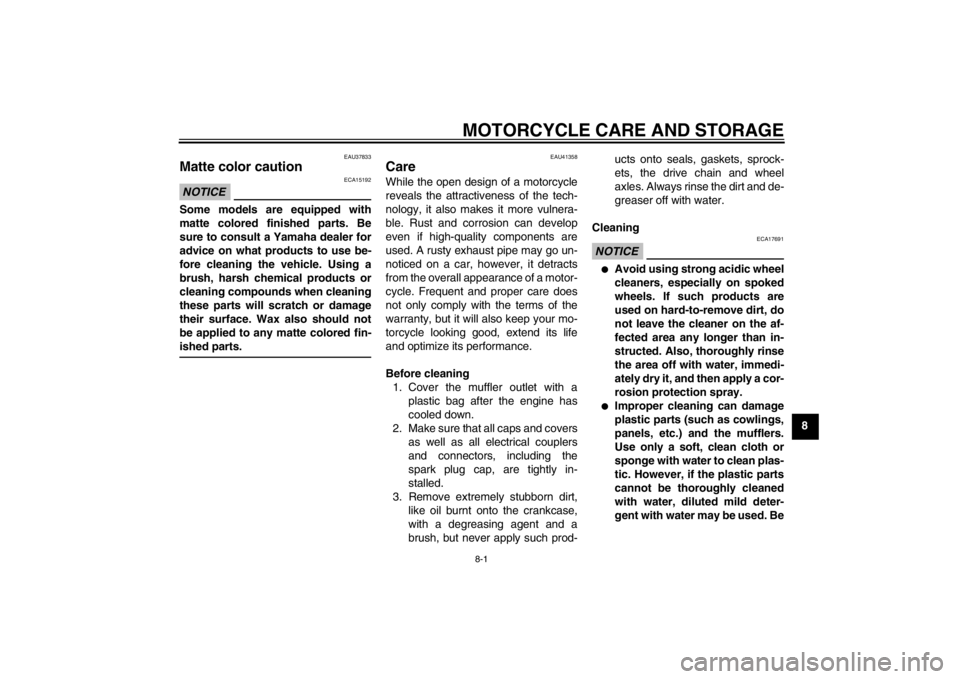
MOTORCYCLE CARE AND STORAGE
8-1
8
EAU37833
Matte color caution NOTICE
ECA15192
Some models are equipped with
matte colored finished parts. Be
sure to consult a Yamaha dealer for
advice on what products to use be-
fore cleaning the vehicle. Using a
brush, harsh chemical products or
cleaning compounds when cleaning
these parts will scratch or damage
their surface. Wax also should not
be applied to any matte colored fin-
ished parts.
EAU41358
Care While the open design of a motorcycle
reveals the attractiveness of the tech-
nology, it also makes it more vulnera-
ble. Rust and corrosion can develop
even if high-quality components are
used. A rusty exhaust pipe may go un-
noticed on a car, however, it detracts
from the overall appearance of a motor-
cycle. Frequent and proper care does
not only comply with the terms of the
warranty, but it will also keep your mo-
torcycle looking good, extend its life
and optimize its performance.
Before cleaning1. Cover the muffler outlet with a plastic bag after the engine has
cooled down.
2. Make sure that all caps and covers as well as all electrical couplers
and connectors, including the
spark plug cap, are tightly in-
stalled.
3. Remove extremely stubborn dirt, like oil burnt onto the crankcase,
with a degreasing agent and a
brush, but never apply such prod- ucts onto seals, gaskets, sprock-
ets, the drive chain and wheel
axles. Always rinse the dirt and de-
greaser off with water.
Cleaning
NOTICE
ECA17691
●
Avoid using strong acidic wheel
cleaners, especially on spoked
wheels. If such products are
used on hard-to-remove dirt, do
not leave the cleaner on the af-
fected area any longer than in-
structed. Also, thoroughly rinse
the area off with water, immedi-
ately dry it, and then apply a cor-
rosion protection spray.
●
Improper cleaning can damage
plastic parts (such as cowlings,
panels, etc.) and the mufflers.
Use only a soft, clean cloth or
sponge with water to clean plas-
tic. However, if the plastic parts
cannot be thoroughly cleaned
with water, diluted mild deter-
gent with water may be used. Be
U1SN81E0.book Page 1 Tuesday, June 12, 2012 3:17 PM
Page 80 of 88

MOTORCYCLE CARE AND STORAGE
8-2
8sure to rinse off any detergent
residue using plenty of water, as
it is harmful to plastic parts.
●
Do not use any harsh chemical
products on plastic parts. Be
sure to avoid using cloths or
sponges which have been in
contact with strong or abrasive
cleaning products, solvent or
thinner, fuel (gasoline), rust re-
movers or inhibitors, brake flu-
id, antifreeze or electrolyte.
●
Do not use high-pressure wash-
ers or steam-jet cleaners since
they cause water seepage and
deterioration in the following ar-
eas: seals (of wheel and swing-
arm bearings, fork and brakes),
electric components (couplers,
connectors, and switches),
breather hoses and vents.
After normal useRemove dirt with warm water, a mild
detergent, and a soft, clean sponge,
and then rinse thoroughly with clean
water. Use a toothbrush or bottlebrush
for hard-to-reach areas. Stubborn dirt and insects will come off more easily if
the area is covered with a wet cloth for
a few minutes before cleaning.
After riding in the rain or near the sea
Since sea salt is extremely corrosive,
carry out the following steps after each
ride in the rain or near the sea.
1. Clean the motorcycle with cold wa- ter and a mild detergent, after the
engine has cooled down.
NOTICE: Do not use warm water
since it increases the corrosive
action of the salt.
[ECA10791]
2. Apply a corrosion protection spray on all metal, including chrome- and
nickel-plated, surfaces to prevent
corrosion.
After cleaning 1. Dry the motorcycle with a chamois or an absorbing cloth.
2. Immediately dry the drive chain and lubricate it to prevent it from
rusting.
3. Use a chrome polish to shine chrome, aluminum and stainless-
steel parts, including the exhaust
system. 4. To prevent corrosion, it is recom-
mended to apply a corrosion pro-
tection spray on all metal,
including chrome- and nickel-plat-
ed, surfaces.
5. Use spray oil as a universal clean- er to remove any remaining dirt.
6. Touch up minor paint damage caused by stones, etc.
7. Wax all painted surfaces.
8. Let the motorcycle dry completely before storing or covering it.
WARNING
EWA11131
Contaminants on the brakes or tires
can cause loss of control.●
Make sure that there is no oil or
wax on the brakes or tires.
●
If necessary, clean the brake
discs and brake linings with a
regular brake disc cleaner or ac-
etone, and wash the tires with
warm water and a mild deter-
gent. Before riding at higher
speeds, test the motorcycle’s
braking performance and cor-
nering behavior.
U1SN81E0.book Page 2 Tuesday, June 12, 2012 3:17 PM